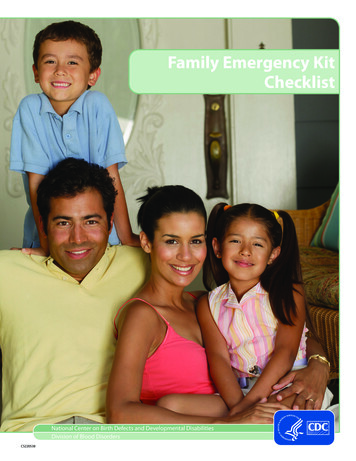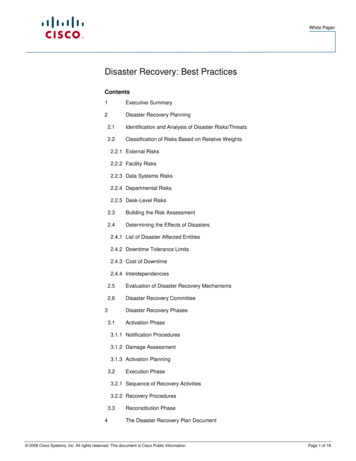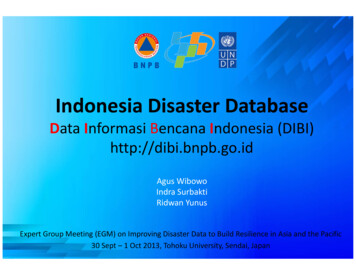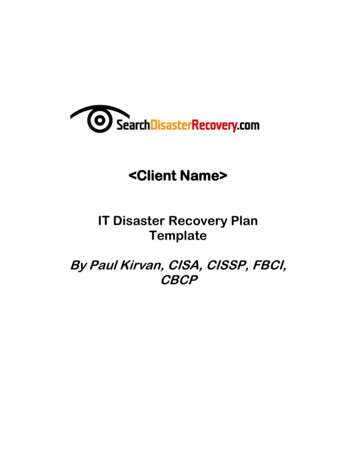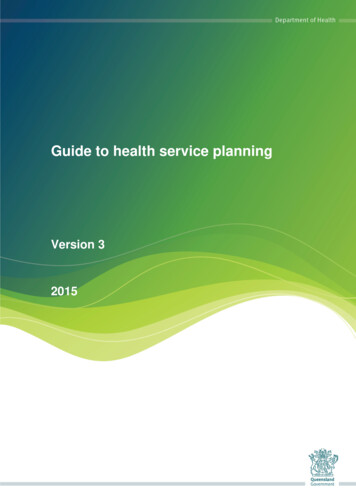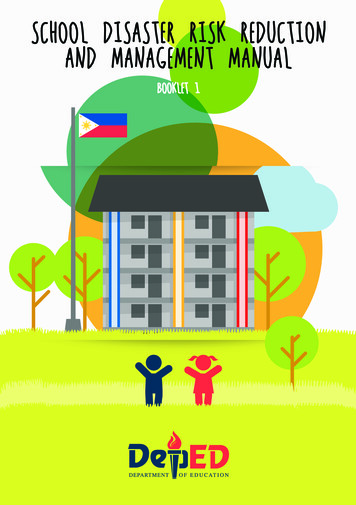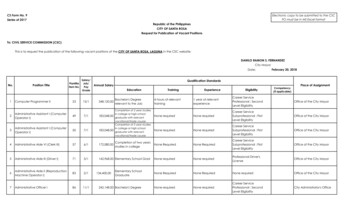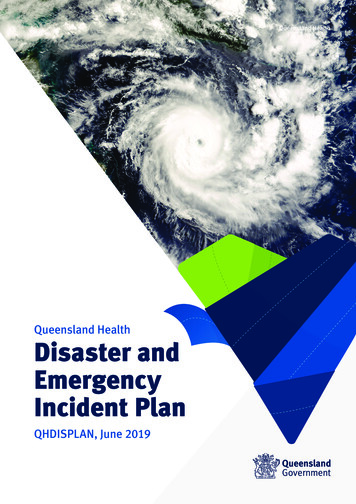
Transcription
Queensland HealthQueensland HealthDisaster andEmergencyIncident PlanQHDISPLAN, June 2019
Queensland Health Disaster andEmergency Incident Plan QHDISPLAN, June 2019Published by the State of Queensland(Queensland Health), July 2019This document is licensed under a CreativeCommons Attribution 3.0 Australia licence.To view a copy of this licence, visitcreativecommons.org/licenses/by/3.0/au State of Queensland (Queensland Health) 2019For more information contact:Health Disaster Management Unit,Queensland Health, GPO Box 48,Brisbane QLD uphone (07) 3708 5221.An electronic version of this document isavailable ter/managementYou are free to copy, communicate and adapt thework, as long as you attribute the State ofQueensland (Queensland Health).Disclaimer:The content presented in this publication is distributed by the Queensland Government as an informationsource only. The State of Queensland makes no statements, representations or warranties about the accuracy,completeness or reliability of any information contained in this publication. The State of Queensland disclaimsall responsibility and all liability (including without limitation for liability in negligence) for all expenses, losses,damages and costs you might incur as a result of the information being inaccurate or incomplete in any way,and for any reason reliance was placed on such information.Queensland Health Disaster and Emergency Incident Plan — QHDISPLAN, June 2019Page 2 of 75
Authorisation statementThe Queensland Health Disaster and Emergency Incident Plan(QHDISPLAN) is issued under the authority of the Director-Generaland is the functional health plan to support the Queensland StateDisaster Management Plan.The QHDISPLAN: is the principal document which supports Queensland Health to respond effectively andappropriately to disasters and emergency incidents outlines the systems, processes, roles and responsibilities for all components ofQueensland Health in accordance with the state disaster management arrangements, andis supported by a suite of documents, including sub-plans, frameworks and guidelines supports Hospital and Health Services and complements Queensland Ambulance Serviceplans in disaster or emergency incident response.The Chief Health Officer and Deputy Director-General (CHO & DDG) Prevention Division,on behalf of the Director-General, maintains the QHDISPLAN for Queensland Health.The 2019 QHDISPLAN is hereby approved and recommended for distribution.Director-GeneralDate:Authority to activateThe QHDISPLAN and relevant sub-plans will be activated under the authority of theDirector-General or the CHO & DDG Prevention Division.Activation of the QHDISPLAN may lead to the activation of the State Health EmergencyCoordination Centre.Director-GeneralDate:Queensland Health Disaster and Emergency Incident Plan — QHDISPLAN, June 2019Page 3 of 75
Version ControlThis plan will be updated electronically and available on the QH intranet and internet sites. Theelectronic copy is the master copy and, as such is the only copy, which is recognised as beingcurrent.To ensure currency, holders should insert amendments to the plan as soon as they arereceived. When an amendment is inserted into the plan, the amendment should be recorded inthe schedule below.AmendmentNumberEnteredIssued (date)SignatureDateQueensland Health Disaster and Emergency Incident Plan — QHDISPLAN, June 2019Page 4 of 75
ContentsAuthorisation statement3Authority to activate3Version Control4Chapter 1: Introduction71.11.21.31.41.51.6AimScopeLegislation and policySupporting documentsDefinitionsReview requirements7889911Chapter 2: Strategic direction and priorities122.1 Disaster management principles2.2 Queensland Emergency Management Assurance Framework2.3 Queensland State Disaster Management Plan121314Chapter 3: Disaster management structure173.1 Queensland disaster management structure3.2 Queensland Health representation1719Chapter 4: Effective disaster and emergency incident planning214.1 Planning architecture4.2 Hierarchy of plans and legislation4.3 Planning consistency and requirements4.4 Planning for emergencies in health care facilities4.5 Risk, Resilience and the comprehensive approach to disaster and emergency incidentmanagement21222425Chapter 5: Operation of ion pathwaysNotification cascadeAuthority to activate QHDISPLANTriggers for activationDeclaration of a disasterExample activation and notification process26Chapter 6: Emergency coordination and operations ncy Operation Centre requirementsIncident management functionsState Health Emergency Coordination CentreHealth Emergency Operations CentreState Disaster Coordination CentreDebriefDocumentation and reportingQueensland Health Disaster and Emergency Incident Plan — QHDISPLAN, June 2019Page 5 of 76
Appendix53Appendix 153Appendix 256Appendix 361Appendix 464Appendix 571Appendix 674Queensland Health Disaster and Emergency Incident Plan — QHDISPLAN, June 2019Page 6 of 76
Chapter 1: IntroductionAimThe aim of the Queensland Health Disaster and Emergency IncidentPlan (QHDISPLAN) is to describe the Queensland Healtharrangements for the response to a disaster or emergency incident.The QHDISPLAN supports the achievement of Queensland Health responsibilities under theQueensland State Disaster Management Plan (the QSDMP) and the Queensland RecoveryPlan, which enable the guiding principles of the Disaster Management Act 2003 (the DM Act).Queensland Health Disaster and Emergency Incident Plan — QHDISPLAN, June 2019Page 7 of 75
ScopeThe QHDISPLAN and its associated sub-plans apply to the Department of Health (theDepartment) and all Hospital and Health Services (HHSs). The QHDISPLAN provides forsupport to HHSs, which have individual disaster and emergency incident plans, sub-plans anda responsibility for managing the health response to disasters and emergency incidents at alocal and district level. The Department will support and coordinate such responses at a statelevel.The QHDISPLAN does not incorporate requirements for the Queensland Ambulance Service(QAS). The QAS describes its arrangements for response to a disaster or emergency incidentin the State Major Incident and Disaster Plan.The QHDISPLAN and HHS plans can also be used by partner agencies to inform disaster andemergency incident planning. This includes, but is not limited to: private hospitals and health care providers aged care providers Primary Health Networks disaster management groups.Legislation and policyThe DM Act provides the legislative basis for disaster management arrangements inQueensland.The QSDMP describes Queensland’s disaster management arrangements and approach todisaster management in support of the guiding principles and objects of the DM Act.The QHDISPLAN supports and enables other Acts, standards and policies which provide fordisaster and emergency incident management roles and responsibilities. These include, butare not limited to: Fire and Emergency Services Act 1990 Food Act 2006 Hospital and Health Boards Act 2011 Public Health Act 2005 Public Safety Preservation Act 1986 Radiation Safety Act 1999 Work Health and Safety Act 2011 AS4083-2010 ‘Planning for emergencies – Health care facilities’ Department of Health Policy QH-POL-315:2018 ‘Disasters and Emergency Incidents’ Department of Health Standard QH-IMP-315:2018 ‘Disasters and Emergency Incidents’Queensland Health Disaster and Emergency Incident Plan — QHDISPLAN, June 2019Page 8 of 75
Emergency Management Assurance Framework and the Standard for DisasterManagement in Queensland1 Health Service Directive QH-HSD-003-2017 ‘Disasters and Emergency Incidents’ Health Service Directive QH-HSD-046-2014 ‘Management of a public health event of statesignificance’ The Australian Council on Healthcare Standards National Safety and Quality HealthService Standards 2nd edition 2019 (or equivalent).Supporting documentsThe QHDISPLAN is supported by: Queensland Health Disaster and Emergency Incident Sub-plans the Queensland Health Disaster and Emergency Incident Training Framework the Queensland Health Incident Management System Guideline (QH IMS Guideline) the Queensland Health Operational Briefing and Debriefing Guideline.DefinitionsA disaster is defined in Section 13 of the DM Act as:‘a serious disruption in a community, caused by the impact of an event, thatrequires a significant coordinated response by the State and other entities to helpthe community recover from the disruption.’Health Organization 2006In this section, serious disruption means-A. loss of human life, or illness or injury to humans; orB. widespread or severe property loss or damage; orC. widespread or severe damage to the environment.1Published by the Office of the Inspector-General Emergency Management, Queensland Government.Queensland Health Disaster and Emergency Incident Plan — QHDISPLAN, June 2019Page 9 of 75
An event is defined in Section 16 of the DM Act as:any of the following—A. a cyclone, earthquake, flood, storm, storm tide, tornado, tsunami, volcanic eruption orother natural happening;B. an explosion or fire, a chemical, fuel or oil spill, or a gas leak;C. an infestation, plague or epidemic;D. a failure of, or disruption to, an essential service or infrastructure;E. an attack against the State;F. another event similar to an event mentioned in paragraphs (a) to (e).An event may be natural or caused by human acts or omissions.An emergency incident is any incident not defined under the DM Act, but that meets one ormore of the following criteria: is confined to activation of a single Health Emergency Operations Centre (HEOC) in asingle HHS may result in moderate or medium impact on normal operations for a hospital or a specificfunction within a HHS, such as mental health or public health functions can be resolved through use of local resources or reciprocal arrangements may involve the State Health Emergency Coordination Centre (SHECC) moving to ‘Alert’ or‘Lean Forward’ level of activation, dependent on situation reporting requirements. 2Note these may include mental health, clinical services, infrastructure disruptions or level 1public health incidents.A public health emergency (which must be declared by the Minister) is defined in Section 315of the Public Health Act 2005 as:‘an event or a series of events that has contributed to, or may contribute to, seriousadverse effects on the health of persons in Queensland’.2Emergency incidents may also be categorised as incidents which require a coordinated response at a state level, but donot necessarily meet the definition of an event or a disaster under the DM Act. These incidents may be managed under asub-plan to the QHDISPLAN, for example the Mental Health Sub-plan for an emergency incident requiring a mental healthresponse. Definitions for specific emergency incidents can be found within relevant sub-plans. Note that throughout theQHDISPLAN the term ‘incident’ may also be used as a generic term to describe any occurrence requiring a coordinatedresponse.Queensland Health Disaster and Emergency Incident Plan — QHDISPLAN, June 2019Page 10 of 75
A public health incident is:‘any event that may have negative consequences for human health on a population basis’,A public health incident is classified according to three levels: Level 1 Public health incident of local significance Level 2 Public health incident of state significance Level 3 Major public health incident or disaster. 3Review requirementsThe QHDISPLAN and associated sub-plans shall be reviewed:1.annually as a minor review, with amendments made based on potential impact andimportance, otherwise a major review will be conducted every three years2. following structural or organisational changes impacting Queensland Health operations3. following legislative changes affecting Queensland Health operations4. following changes in state or federal nomenclature or arrangements5. following activation resulting in identified improvements, including through major exercises.3Further information and definitions of each level of public health incident is provided in the Public Health Sub-plan. Theselevels also align with the levels of response for events and emergency incidents provided in section 4 of the QHDISPLAN.Queensland Health Disaster and Emergency Incident Plan — QHDISPLAN, June 2019Page 11 of 75
Chapter 2: Strategic direction andpriorities2.1 Disaster management principlesThe principles at section 4A of the DM Act guide the development and implementationof disaster management policy, plans and programs at state, district and local levels.The principles are: a comprehensive approach to disaster management across prevention, preparedness,response and recovery (PPRR) an all-hazards approach which applies to all events, whether natural or caused byhuman acts or omissions local disaster management capability which forms the frontline of disaster management support by disaster district and state levels to the local level.Queensland Health Disaster and Emergency Incident Plan — QHDISPLAN, June 2019Page 12 of 75
Disaster management is also underpinned by four supporting principles contained within theQueensland Emergency Management Assurance Framework (EMAF), developed by the Officeof the Inspector General Emergency Management (IGEM): leadership public safety partnership performance.Queensland Health’s disaster and emergency incident arrangements are based on theprinciples of both the DM Act and the EMAF, which are incorporated into all planning,operations, directives, policies and standards for disaster and emergency incidentmanagement.Consistent with the principle of ‘support by disaster districts and state levels to the local level’: each HHS is primarily responsible for managing events in its local area the Department coordinates appropriate resources and support to assist HHSs in disastermanagement and disaster operations.2.2 Queensland Emergency ManagementAssurance FrameworkActivities and outcomes across all levels of disaster and emergency management inQueensland are underpinned by the EMAF. The principles of this framework focus onleadership, public safety, partnerships and performance, upon which Queensland Health’sdisaster management arrangements are based 4. The framework contains the Standard forDisaster Management in Queensland. Consistent with the framework and standard, theQHDISPLAN supports arrangements that are: Scalable: Arrangements can be applied to any size or type of event and across all levels ofQueensland’s disaster management arrangements Comprehensive: Considers all phases of disaster management, all hazards and an allagencies approach Interoperable: promotes linkages and partnerships between systems, programs andpeople, to enable sharing of information and coordinated activities across the sector Value: ensures the value of services and systems is considered in terms of cost, fitnessfor purpose, quality, and the advancing of broader economic, environmental and socialobjectives Adaptable: arrangements can adapt to a changing climate and environment, remainingflexible to the needs of the community.4Via the Disasters and Emergency Incidents Health Service Directive, Policy and Implementation Standard.Queensland Health Disaster and Emergency Incident Plan — QHDISPLAN, June 2019Page 13 of 75
2.3 Queensland State Disaster Management PlanThe Queensland State Disaster Management Plan (QSDMP) describes the arrangements toenable the guiding principles of the DM Act. All events, whether natural or caused by humanacts, should be managed in accordance with this plan.The following Queensland Health responsibilities are detailed in Annexure C of the QSDMP.QUEENSLAND HEALTHEmergencysupport functions Public health, mental health and medical services Emergency aeromedical retrieval Mass casualty management Mass fatality management. Coordinate and manage the health aspects of a disaster oremergency incident across the full spectrum of prevention,preparedness, response and recovery including health advice tothe community, public health, clinical care, forensic support andmental health.RoleResponsibilitiesLead agency Lead agency for response functions of public health, mental healthand medical services, mass casualty management, mass fatalitymanagement including victim identification (with the QueenslandPolice Service - QPS) and emergency medical retrieval. Provide health emergency incident information. Primary agency for heatwave, pandemic influenza, biological andradiological incidents.Representation State representation at Australian Health Protection PrincipalCommittee and associated sub-committees includingCommunicable Diseases Network Australia (CDNA), Public HealthLaboratory Network (PHLN) and the National Health EmergencyManagement Standing Committee. Department of Health participation in appropriate and relevantstate level groups and committees. Hospital and Health Service participation in LDMG and DDMGactivities.Preparedness Develop health-focused disaster and emergency preparedness,response and recovery plans. Develop and maintain disaster and emergency health responsecapability and capacity.Queensland Health Disaster and Emergency Incident Plan — QHDISPLAN, June 2019Page 14 of 75
Implement business continuity plans and arrangements to maintainhealth services during disasters and emergencies. Work across the health sector including aged care facilities, privatefacilities, primary health and community care providers to ensure‘whole of health’ arrangements are in place.Response (including support functions) Coordinate the state level health response through maintenanceand activation of the SHECC. Provide health disaster and emergency information to the publicand disaster management stakeholders. Health services – clinical and forensic. Clinically coordinate aeromedical transport and emergency medicalretrieval (with QAS) and provide membership to the State DisasterCoordination Centre (SDCC) aviation cell when activated. Clinical response to mass casualty management (with QAS). Forensic and scientific health services to mass fatalitymanagement and terrorism (with QPS). Recovery mental health support to affected communities(with DCDSS). Public health and environmental health advice and support to localgovernments and affected communities and industries. Environmental health risk assessment advice to other agencies,local government and industries. Messaging on public health risks to affected communities. Communicable disease surveillance and response arrangements.Queensland Health Disaster and Emergency Incident Plan — QHDISPLAN, June 2019Page 15 of 75
QUEENSLAND AMBULANCE SERVICEProvide, operate and maintain ambulance services and servicedelivery during rescue and other related activities. This includesprotecting persons from injury or death, whether or not the individualsare sick or injured.RoleProvide transport for persons requiring attention at medical or healthcare facilities, to participate with other emergency services in counterdisaster planning and to coordinate all volunteer first aid groups duringthe disaster.Responsibilities Provide, operate and maintain ambulance services. Access, assess, treat and transport sick and injured persons. Protect persons from injury or death, during rescue and otherrelated activities. Coordinate all volunteer first aid groups during major emergenciesand disasters. Provide and support temporary health infrastructure whererequired. Collaborate with Retrieval Services Queensland in the provision ofparamedics for rotary wing operations. Participate in search and rescue, evacuation and victim receptionoperations. Participate in health facility evacuations. Collaborate with Queensland Health in mass casualtymanagement systems. Provide disaster, urban search and rescue (USAR), Chemicalhazard (Hazmat), biological and radiological operations supportwith specialist logistics and specialist paramedics.Table 1 Queensland Health and Queensland Ambulance Service roles and responsibilities in the QueenslandState Disaster Management PlanPlanning arrangements for QAS to meet these accountabilities are in theQAS State Major Incident and Disaster Plan.Queensland Health Disaster and Emergency Incident Plan — QHDISPLAN, June 2019Page 16 of 75
Chapter 3: Disaster managementstructure3.1 Queensland disaster management structureDisaster management in Queensland is managed through a four-tiered state and nationalstructure, with local government primarily responsible for managing events and incidents intheir local government area. An explanation of the role of each tier is in the QSDMP.Disaster management groups, coordination groups or committees support each level and meetto prepare for and practise their role within the disaster management arrangements. Whenactivated, these groups manage and coordinate responses to disasters at the appropriatelevel. The groups are outlined in Table 2.The state level includes the Queensland Disaster Management Committee (QDMC), whichmakes strategic decisions about prevention, preparedness, response and recovery for disasterevents. The QDMC is chaired by the Premier with a clear line of communication and decisionmaking between the Premier, relevant Ministers and both the State Disaster Coordinator (SDC)and the State Disaster Coordination Group (SDCG).Queensland Health Disaster and Emergency Incident Plan — QHDISPLAN, June 2019Page 17 of 75
A fourth level, the Australian Government, recognises that Queensland may need to seekAustralian Government support in times of disaster. The Department of Home Affairs (Emergency Management Australia) is theCommonwealth agency responsible for planning and coordinating Australian Governmentand interstate assistance to states and territories under the Australian Government CrisisManagement Framework. The Australian Government Crisis Coordination Centre (CCC) provides whole-ofgovernment situational awareness to inform national decision making during a crisis andcoordinates physical Australian Government emergency assistance.Basis forBoundariesLocalDistrictStateLocal government areaboundaries (77 localgovernment areas and 1town authority - seeAppendix 4)Queensland PoliceService (QPS) districtboundaries (22 disasterdistricts - see Appendix4)State of Queensland(1)District DisasterManagement Group(DDMG)Queensland DisasterManagementCommittee (QDMC)Local DisasterResponsibleManagement GroupGroup(LDMG)State DisasterCoordination Group(SDCG)OperationalLeadOperationalFacilityLocal DisasterCoordinator (LDC)District DisasterCoordinator (DDC)Premier StateDisaster Coordinator(SDC)Local DisasterCoordination Centre(LDCC)District DisasterCoordination Centre(DDCC)State DisasterCoordination Centre(SDCC)Table 2 Queensland disaster management groups and committeesQueensland Health Disaster and Emergency Incident Plan — QHDISPLAN, June 2019Page 18 of 75
3.2 Queensland Health representationDepartment of Health The Department of Health provides representation at the state level to the QDMC, SDCG,and the SDCC. Disaster and emergency incident management activities at the Department level arecoordinated by the SHECC under the direction of a State Health Coordinator (SHC). 5 At the national level for health, the peak health body for disaster management is theAustralian Health Protection Principal Committee (AHPPC). The Chief Medical Officer forthe Australian Government chairs the AHPPC with representation provided by the ChiefHealth Officer of each jurisdiction. The National Incident Room (NIR), AustralianGovernment Department of Health, supports the AHPPC.Hospital and Health Services HHSs provide representation at a disaster district level to the DDMG/DDCC. Hospitalswithin the HHS, or the HHS itself, may also provide representation to the LDMG/LDCC. Disaster and emergency incident management activities in hospitals and HHSs arecoordinated through HEOCs under the direction of a Health Incident Controller (HIC).Queensland Ambulance Service The QAS is represented at all levels of disaster management activities and, whileindependent in operation, works collaboratively with the HHSs and the Department. The QAS provides representation at the state level to the QDMC, SDCG and SDCC. The QAS provides representation at a disaster district level to the DDMG/DDCC, and at thelocal level to the LDMG/LDCC. QAS incident management activities are coordinated at the state level in the State IncidentManagement Room (SIMR) and at the Local Area Service Network (LASN) level in a LocalAmbulance Coordination Centre (LACC).Table 3 below outlines how Queensland Health participates in the disaster managementarrangements and provides national representation.The disaster management arrangements ensure support and assistance is available todisaster-affected communities through the escalation of requests for assistance from local todistrict and to state level (see Appendix 3 – Requests for Assistance), and where appropriate tonational level. Consistent with this: HHSs are primarily responsible for managing events in their local areas. the Department coordinates appropriate resources and support to assist HHSs in disastermanagement and disaster operations.5Refer to the Public Health Sub-plan for details of public health incidents which are coordinated by a Public HealthEmergency Operations Centre (PHEOC).Queensland Health Disaster and Emergency Incident Plan — QHDISPLAN, June 2019Page 19 of 75
Just as there may be multiple local governments and disaster districts affected and multipleLDMG and DDMG activated, there may be multiple health facilities and HHS affected andactivated.LevelDisaster management groupHealth participationNationalAustralian Government:Australian Government Department ofHealth:StateDistrictLocalSite Emergency Management Australia Crisis Coordination Centre Australian Health ProtectionPrincipal Committee National Incident RoomQueensland Government:Queensland Department of Health: Queensland Disaster ManagementCommittee State Health EmergencyCoordination Centre State Disaster CoordinationCentre State Health CoordinatorDisaster Districts:Hospital and Health Services: District Disaster ManagementGroups Health Emergency OperationCentres District Disaster CoordinationCentres Health Incident ControllerLocal governments:Health facilities: Local Disaster ManagementGroups Health Emergency OperationCentres Local Disaster CoordinationCentres Health Incident Controller 6Sites:Sites: Site CommanderHealth CommanderTable 3 Queensland Health participation in the Queensland disaster management arrangements6Health Emergency Operations Centres may be established at HHS and hospital levels. Depending on the level and contextof an event or incident, a Hospital or Directorate Commander may also be in place. This is particularly relevant to largerHHSs.Queensland Health Disaster and Emergency Incident Plan — QHDISPLAN, June 2019Page 20 of 75
Chapter 4: Effective disaster andemergency incident planning4.1 Planning architectureIn line with the Queensland disaster management arrangements, effective disastermanagement planning includes: documenting how the Department, HHSs and hospitals intend to deal with the effects ofhazards and disaster events across prevention, preparedness, response and recovery hazard identification and mitigation, and risk assessment and reduction outlining arrangements, roles and responsibilities and structures for disaster andemergency incident management providing direction on communications, escalation points, coordination and resourcingrequirements collaborating with stakeholders to enable accessibility and understanding of the plans andarrangements.Consistent with this, the QHDISPLAN incorporates three levels of planning. This helps toensure integration of planning and an understanding of the relevant capabilities, relationships,objectives and resource requirements across Queensland Health and partner agencies.Queensland Health Disaster and Emergency Incident Plan — QHDISPLAN, June 2019Page 21 of 75
Strategic level – sets the context and expectations for operational planning (governance,priorities, desired outcomes).Operational level – provides tasks and resources needed to execute the strategy.Tactical level – details how to apply resources to complete operational tasks within a giventimeline.The QSDMP also identifies four priority areas that contribute to effective disaster managementin Queensland: risk management planning local focus resilienceThe QHDISPLAN aligns with the QSDMP and addresses these four priority areas.4.2 Hierarchy of plans and legislationThe hierarchy of plans (Table 4) consists of national, state, district and local plans, consistentand aligned with whole of government planning and disaster management.LevelMulti-agency planHealth planCOMMDISPLANAUSTRAUMAPLANStateQueensland State DisasterManagement PlanQueensland Health Disaster and EmergencyIncident PlanDistrictDistrict Disaster ManagementPlanHHS Disaster and Emergency Incident Plan 7Local Disaster Management PlanHospital or health facility Disaster andEmergency Incident PlanNationalLocalTable 4 Hierarchy of plansThe NatHealth Arrangements operate within the context of the Australian Government nationalsecurity framework, which includes the provisions of the National Emergency CoordinationFramework, the Commonwealth Disaster Plan (COMDISPLAN), the National CounterTerrorism Plan, the National Counter-Terrorism Handbook and the Council of AustralianGovernments (COAG) endorsed Model Arrangements for Leadership during Emergencies ofNational Consequence.7HHS level plans may also be titled Emergency Preparedness and/or Response, Emergency Management etc., however willmeet the same requirements.Queensland Health Disaster and Emergency Incident Plan —
The QSDMP describes Queensland’s disaster management arrangements and approach to disaster management in support of the guiding principles and objects of the DM Act. The QHDISPLAN supports and enables other Acts, standards and policies which provide for disaster and emergency incident managemen
